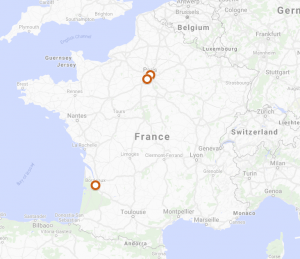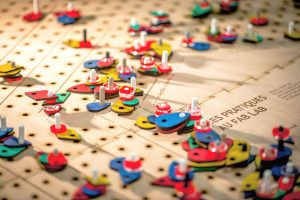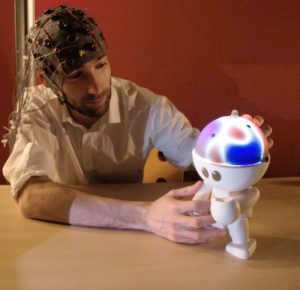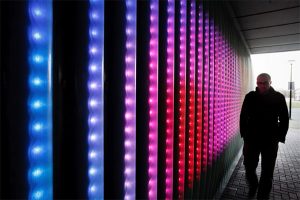(a) Situated visualization concepts for fitness and food (by Wesley Willett); (b) Cairns invites Fablab visitors to record their activities using wooden tiles (by Pauline Gourlet); (c) Teegi is a physical puppet displaying brain activity in real-time (by Jérémy Frey et al.); (d) Moodwall reacts to the movement of passers-by dynamic light changes (by Studio Klink et al.) ; (e) Infotropism is a group of living plants showing the usage frequency of a nearby recycling bin (by David Holstius et al.) Click on each image for more info.
What is Ember?
Ember is a project funded by ANR (Agence Nationale de la Recherche, grant ANR-19-CE33-0012) that joins the efforts of three French teams known for their research in human-computer interaction and information visualization:
- The Aviz team at Inria Saclay (Paris area),

- The HCI Sorbonne group at Sorbonne Université (Paris),
- The Potioc team at Inria Bordeaux.
The goal of the project will be to study how embedding data into the physical world can help people get insights into their own activities. While the vast majority of data analysis and visualization takes place on desktop computers located far from the objects or locations the data refers to, in situated and embedded data visualizations, the data is directly visualized near the physical space, object, or person it refers to. The project will be funded from 2020 to 2024.
Keywords: information visualization, human-computer interaction, personal data, user interface evaluation, augmented reality, ubiquitous computing, physical visualization, data physicalization, immersive analytics.
Team
- Pierre Dragicevic, CR Inria Saclay (Inria Bordeaux since Sep 2021), project coordinator and student advisor
- Petra Isenberg, CR Inria Saclay, student advisor
- Martin Hachet, DR Inria Bordeaux, student advisor
- Yvonne Jansen, CR CNRS and Sorbonne Université (Inria Bordeaux since Sep 2021), student advisor
- Gilles Bailly, CR CNRS and Sorbonne Université, student advisor.
- Luiz Morais, post-doctoral researcher working with Pierre Dragicevic. Topics: personal traces, situated task sharing.
- Morgane Koval, PhD student with Yvonne Jansen and Gilles Bailly. Topic: situated displays for behavior change.
- Lijie Yao, PhD student with Petra Isenberg and Anastasia Bezerianos. Topic: situated visualizations in motion.
- Ambre Assor, PhD student with Martin Hachet, Pierre Dragicevic, and Arnaud Prouzeau. Topic: immersive situated visualizations of personal data.
- Federica Bucchieri, Master’s intern with Lijie Yao and Petra Isenberg. Topic: Embedded visualization in motion in video games.
- Léana Petiot, Master’s intern with Pierre Dragicevic and Hélène Sauzéon. Topic: Augmented reality and involuntary memory.
Former members
- Kim Sauvé, visiting PhD student working with Yvonne Jansen and Pierre Dragicevic. Topic: participatory data physicalization.
- Rafael Blanco, Master’s intern advised by Pierre Dragicevic in 2020. Topic: situated displays of nutritional information.
External collaborators (co-advisors and possible internship hosts)
- Arnaud Prouzeau, Inria Bordeaux, France
- Anastasia Bezerianos, University Paris-Saclay, France
- Wesley Willett, Data Experience Lab, University of Calgary, Canada
- Lora Oehlberg, University of Calgary, Canada
- Sheelagh Carpendale, Simon Fraser University, Canada
- Ullo, Bordeaux, France
Jobs
The Ember project will be hiring four Master’s interns in 2021 and 2022.
International students are welcome. English proficiency required, Speaking French not required.
For complementary information about a specific position, please contact the advisors listed above. For general information about the Ember project, please contact the project coordinator pierre.dragicevic [at] inria.fr.
Project Summary
The Ember project will study how situated data visualization systems can help people use their personal data (e.g., fitness and physiological data, energy consumption, banking transactions, online social activity,…) for their own benefit. Although personal data is generated in many areas of daily life, it remains underused by individuals. Rarely is personal data subjected to an in-depth analysis and used to inform daily decisions. This research aims to empower individuals to improve their lives by helping them become advanced consumers of their own data.
This research builds on the area of personal visual analytics, which focuses on giving the general public effective and accessible tools to get insights from their own data. Personal visual analytics is a nascent area of research, but has so far focused on scenarios where the data visualization is far removed from the source of the data it refers to. The goal of this project is to address the limitations of traditional platforms of personal data analytics by exploring the potential of situated data visualizations.
In a situated data visualization, the data is directly visualized near the physical space, object, or person it refers to. Situated data visualizations have many potential benefits: they can surface information in the physical environment and allow viewers to interpret data in-context; they can be tailored to highlight spatial connections between data and the physical environment, making it easier to make decisions and act on the physical world in response to the insights gained; and they can embed data into physical environments so that it remains visible over time, making it easier to monitor changes, observe patterns over time and collaborate with other people.
Although the topic of situated visualization is currently gaining traction in research, currently very few real applications exist, and little empirical data is available on how to design such systems. We will address this gap by building functional prototypes whose utility will be evaluated using rigorous empirical methods, and by deriving theories and general design guidelines that extend beyond the problem areas considered.
The overall research program will be broken down into four research problems led by five researchers from three research labs (Inria Saclay, Inria Bordeaux, Sorbonne Université) with complementary areas of expertise. The consortium will be completed by graduate students, a postdoctoral researcher and short-term interns to work on four specific research problems and develop the hardware and software necessary for the successful completion of the project.
This project is expected to generate benefits at multiple levels, including to society (by empowering individuals with technology), to the scientific community (by extending and unifying two nascent research areas), to the academic partners (by reinforcing existing research links and establishing them as leaders on the topic), and to students (by providing them with unique training opportunities with a diverse team of world-class researchers).
Publications
2024
Journal articles
- titre
- Animating Hypothetical Trips to Communicate Space-Based Temporal Uncertainty on Digital Maps
- auteur
- Morgane Koval, Yvonne Jansen, Fanny Chevalier
- article
- IEEE Transactions on Visualization and Computer Graphics, In press, pp.1-11. ⟨10.1109/TVCG.2024.3388517⟩
- Accès au texte intégral et bibtex
-


- titre
- Designing for Visualization in Motion: Embedding Visualizations in Swimming Videos
- auteur
- Lijie Yao, Romain Vuillemot, Anastasia Bezerianos, Petra Isenberg
- article
- IEEE Transactions on Visualization and Computer Graphics, 2024, 30 (3), pp.1821-1836. ⟨10.1109/tvcg.2023.3341990⟩
- Accès au texte intégral et bibtex
-


- titre
- Augmented-Reality Waste Accumulation Visualizations
- auteur
- Ambre Assor, Arnaud Prouzeau, Pierre Dragicevic, Martin Hachet
- article
- ACM Journal on Computing and Sustainable Societies, 2024, ⟨10.1145/3636970⟩
- Accès au texte intégral et bibtex
-


Conference papers
- titre
- The Weight of Our Decisions: Encoding Carbon Impact with Physical Load
- auteur
- Edwige Chauvergne, Aymeric Ferron, Pierre Dragicevic
- article
- IHM 2024 – 35e Conférence Internationale Francophone sur l’Interaction Humain-Machine, Mar 2024, Paris, France
- Accès au texte intégral et bibtex
-


Preprints, Working Papers, …
- titre
- Exploring the Design of Animated Transitions between Abstract and Concrete Visualizations in Immersive Environments
- auteur
- Ambre Assor, Michael J Mcguffin, Arnaud Prouzeau, Pierre Dragicevic, Martin Hachet
- article
- 2024
- Accès au texte intégral et bibtex
-


- titre
- Augmented Reality Waste Accumulation Visualizations
- auteur
- Ambre Assor, Arnaud Prouzeau, Pierre Dragicevic, Martin Hachet
- article
- 2024
- Accès au texte intégral et bibtex
-


2023
Journal articles
- titre
- Handling Non-Visible Referents in Situated Visualizations
- auteur
- Ambre Assor, Arnaud Prouzeau, Martin Hachet, Pierre Dragicevic
- article
- Transactions on Visualization & Computer Graphics (TVCG), 2023
- Accès au texte intégral et bibtex
-


Conference papers
- titre
- Exploring Augmented Reality Waste Data Representations for Eco Feedback.
- auteur
- Ambre Assor, Arnaud Prouzeau, Pierre Dragicevic, Martin Hachet
- article
- CHI 2023 – Conference on Human Factors in Computing Systems, Apr 2023, Hambourg, Germany. pp.1-4, ⟨10.1145/3544549.3583905⟩
- Accès au texte intégral et bibtex
-


- titre
- Edo: A Participatory Data Physicalization on the Climate Impact of Dietary Choices
- auteur
- Kim Sauvé, Pierre Dragicevic, Yvonne Jansen
- article
- TEI 2023 – 17th International Conference on Tangible Embedded and Embodied Interaction, Feb 2023, Warsaw (POLAND), Poland
- Accès au texte intégral et bibtex
-


2022
Journal articles
- titre
- Visualization in Motion: A Research Agenda and Two Evaluations
- auteur
- Lijie Yao, Anastasia Bezerianos, Romain Vuillemot, Petra Isenberg
- article
- IEEE Transactions on Visualization and Computer Graphics, 2022, 28 (10), pp.3546-3562. ⟨10.1109/TVCG.2022.3184993⟩
- Accès au texte intégral et bibtex
-


- titre
- Showing Data about People: A Design Space of Anthropographics
- auteur
- Luiz Morais, Yvonne Jansen, Nazareno Andrade, Pierre Dragicevic
- article
- IEEE Transactions on Visualization and Computer Graphics, 2022, 28 (3), pp.1661-1679. ⟨10.1109/TVCG.2020.3023013⟩
- Accès au texte intégral et bibtex
-


- titre
- Perception! Immersion! Empowerment! Superpowers as Inspiration for Visualization
- auteur
- Wesley Willett, Bon Adriel Aseniero, Sheelagh Carpendale, Pierre Dragicevic, Yvonne Jansen, Lora Oehlberg, Petra Isenberg
- article
- IEEE Transactions on Visualization and Computer Graphics, 2022, 28 (1), pp.22-32. ⟨10.1109/TVCG.2021.3114844⟩
- Accès au texte intégral et bibtex
-


Conference papers
- titre
- Envisioning Situated Visualizations of Environmental Footprints in an Urban Environment
- auteur
- Yvonne Jansen, Federica Bucchieri, Pierre Dragicevic, Martin Hachet, Morgane Koval, Léana Petiot, Arnaud Prouzeau, Dieter Schmalstieg, Lijie Yao, Petra Isenberg
- article
- VIS4Good – Visualization for Social Good workshop held as part of IEEE VIS 2022, Oct 2022, Oklahoma City, United States. ⟨10.5281/zenodo.7053934⟩
- Accès au texte intégral et bibtex
-


- titre
- Reflections on Visualization in Motion for Fitness Trackers
- auteur
- Alaul Islam, Lijie Yao, Anastasia Bezerianos, Tanja Blascheck, Tingying He, Bongshin Lee, Romain Vuillemot, Petra Isenberg
- article
- MobileHCI 2022 Workshop on New Trends in HCI and Sports, Sep 2022, Vancouver, Canada
- Accès au texte intégral et bibtex
-


- titre
- Visualization in Motion in Video Games for Different Types of Data
- auteur
- Federica Bucchieri, Lijie Yao, Petra Isenberg
- article
- Journée Visu 2022, Jun 2022, Bordeaux, France
- Accès au texte intégral et bibtex
-


- titre
- Situated Visualization in Motion for Swimming
- auteur
- Lijie Yao, Anastasia Bezerianos, Romain Vuillemot, Petra Isenberg
- article
- Journée Visu 2022, Jun 2022, Bordeaux, France
- Accès au texte intégral et bibtex
-


- titre
- Exploring How Visualization Design and Situatedness Evoke Compassion in the Wild
- auteur
- Luiz Morais, Nazareno Andrade, Dandara Sousa
- article
- Eurographics Conference on Visualization (EuroVis) 2022, Jun 2022, Rome, Italy
- Accès au texte intégral et bibtex
-


- titre
- Do You See What You Mean? Using Predictive Visualizations to Reduce Optimism in Duration Estimates
- auteur
- Morgane Koval, Yvonne Jansen
- article
- CHI 2022 – Conference on Human Factors in Computing Systems, Apr 2022, New Orleans, United States. ⟨10.1145/3491102.3502010⟩
- Accès au texte intégral et bibtex
-


Poster communications
- titre
- How to Visualize Food Quantities to Prevent Food Waste? Examples and Challenges
- auteur
- Morgane Koval, Yvonne Jansen
- article
- VIS 2022 – IEEE Visualization & Visual Analytics, Oct 2022, Oklahoma City / Virtual, United States
- Accès au texte intégral et bibtex
-


- titre
- Situated Visualization in Motion for Video Games
- auteur
- Federica Bucchieri, Lijie Yao, Petra Isenberg
- article
- Posters of the European Conference on Visualization (EuroVis), Jun 2022, Rome, Italy. ⟨10.2312/evp.20221119⟩
- Accès au texte intégral et bibtex
-


2021
Conference papers
- titre
- Can Anthropographics Promote Prosociality? A Review and Large-Sample Study
- auteur
- Luiz Morais, Yvonne Jansen, Nazareno Andrade, Pierre Dragicevic
- article
- CHI 2021 – Conference on Human Factors in Computing Systems, May 2021, Yokohama / Virtual, Japan. ⟨10.1145/3411764.3445637⟩
- Accès au texte intégral et bibtex
-


Habilitation à diriger des recherches
- titre
- Micro Visualizations
- auteur
- Petra Isenberg
- article
- Human-Computer Interaction [cs.HC]. Université Paris-Saclay, 2021
- Accès au texte intégral et bibtex
-


2020
Poster communications
- titre
- Situated Visualization in Motion
- auteur
- Lijie Yao, Anastasia Bezerianos, Petra Isenberg
- article
- Posters of the IEEE Conference on Visualization, Oct 2020, Salt Lake City, United States. 2020
- Accès au texte intégral et bibtex
-








